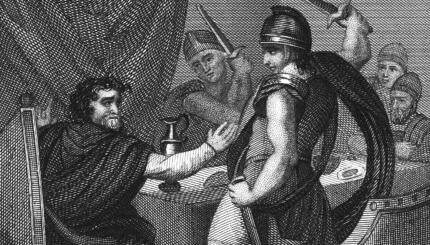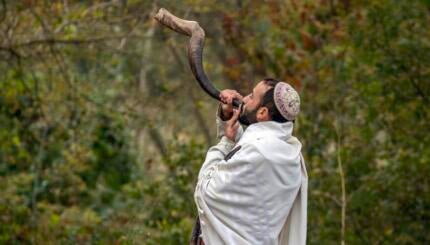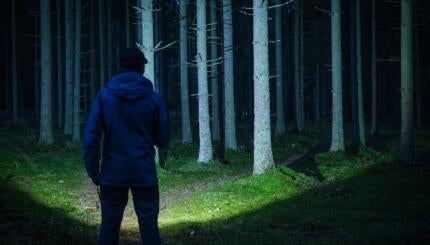This Shabbat, we begin the yearly cycle of Torah readings, the telling of our story again. This is the story of us — of our origins and ancestors, of our trials and tribulations, of our insights and revelations. We begin again, again, in this season of new beginnings.
After the new year of Rosh Hashanah, and the renewed life granted us on Yom Kippur, the joy and connection to nature of Sukkot and the prayers for renewal of the land through rain of Hoshanah Rabbah, we end, as we did this past Monday evening, with Simchat Torah. We danced, sang and celebrated, parading around with our sacred scrolls in preparation for starting our story over again. Though each holiday is a vital component of the holiday cycle, one might argue that Simchat Torah and the Shabbat that follows it are the apex of it all.
We do this year after year, and yet each year we — and the world — are different. Like the parchment wound around the Torah handles, our reading of this story is not circular, but spirilic. We move along the same axis, but drop in and down, unearthing new meanings in the cracks of our old stories.
In a recent conversation on the Sands of Time podcast, writer and activist Bayo Akomolafe described cracks as the places where something new becomes possible. It is here, he says, that we find “the kernel of the yet-to-come.” One of the great blessings of Judaism is that we have inherited a story that is full of these cracks. The Torah is rife with discrepancies and indeterminacies, composed of words with multiple meanings and stories that contain myriad, and even contradictory, interpretations.
With your help, My Jewish Learning can provide endless opportunities for learning, connection and discovery.
Nowhere is this sense of dissonance and possibility more apparent than in the creation story we read this Shabbat. In just these few opening chapters we are left wondering: Are we made in the image of a God who created the world from nothing, or a God who worked with the elements on-hand? Was Adam created first and Eve formed from Adam’s rib, or was the first human being originally a multi-gendered being? Were we meant to be vegetarians, living in partnership with nature, or are we meant to have dominion over the natural world, eating animals as well as plants?
While we might dismiss these stories as untrue (and therefore unimportant), they actually have an immense impact on our lives. Whether we believe them or not, whether we consider ourselves religious or not, these stories are foundational to Western society. Perhaps more than any law or rule, they powerfully — and perhaps, unconsciously — determine our values, priorities and moral code. Even within the stories listed above, we see some of the principal issues of our time: domination as the primary human way of interacting with the world, the existence of a strict gender binary and resource exploitation.
What does it mean to have stories nested within stories that contradict one another? What might we learn if we could tolerate the ambiguity and contradictions the stories hold, letting the varied perspectives remain in conversation? Even more, what does it mean to be a part of a tradition that places these contradictions in plain sight? One possibility is that our tradition prizes possibility, multiplicity, urging us always to wrestle yet again, never to imagine we have the ultimate answer, that we have it all figured out. Perhaps it is between the uneven edges that seem raw and unfinished that new possibilities can emerge.
Author and mythologist Sophe Strand writes, “Myths are like air, invisible until you realize you live inside them, and live or die according to their limitations.” To live inside a myth is to breathe it, to hold and release all of its possible meanings over and over. Reducing a myth to a single meaning transforms it into an instrument of destruction. But we can’t come to understand the myriad possibilities and limitations of our myths unless we wrestle again with our stories, challenging ourselves to notice the discrepancies and wonder what can this mean, rather than what does this mean.
The Mishnah teaches: “Turn it and turn it, for everything is in it.” What could these myths be? What could they — and have they — become? What is it that we need now? Which interpretations are life-sustaining, leading us towards an existence of joy and peace? And which have caused harm, violence, and enmity and need to be understood anew?
From the start of the Hebrew month of Elul, we are called to the spiritual work of teshuvah. Most often defined as an act of repairing harm to our relationships, teshuvah’s literal meaning is actually “returning.” In this season, we return to the places where we’ve missed the mark, sort through what went wrong, take responsibility for our errors, and seek to make amends. Yet this Shabbat, as we return to our foundational stories after many weeks of doing this spiritual work, we might ask the same questions of our stories as we asked of our most important relationships: Where have we missed the mark? What went wrong? How might we make amends?
In this way, we might understand anew everything that we’ve been doing in preparation for this moment. In probing the cracks within our stories, raising them up rather than covering them over, may we find the kernel of the yet-to-come. May we do so with humility, with joy, and with the playful seriousness that this task demands.
This article initially appeared in My Jewish Learning’s Shabbat newsletter Recharge on Oct 22, 2022. To sign up to receive Recharge each week in your inbox, click here.



